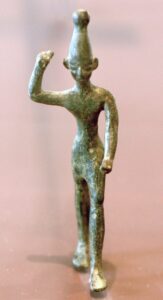
Bronze figurine of a Baal, 14th–12th century BCE, found at Ras Shamra (ancient Ugarit) near the Phoenician coast.
A story about Ugarit in the September/October 1983 BAR explained how Psalm 29 had originally been composed as a Canaanite hymn to the storm god Baal and was later adapted for the Hebrew psalter. The hymn to Baal was modified for inclusion in Israel’s hymn book by replacing the name Baal with Yahweh, the personal name of Israel’s God. It was also modified in other ways, but the dependence of the Israelite hymn on the early Canaanite hymn was clear.
Some readers were offended by this suggestion. One reader said she was “dismay[ed]” and found the suggestion blasphemous (Queries & Comments, BAR 10-01). Others expressed similar views (Queries & Comments, BAR 10-03). The Hebrew psalmist would not use a pagan hymn for inspiration, these readers argued. A lively discussion ensued in BAR’s popular “Queries & Comments” section. For another reaction, see Queries & Comments in this issue.
It will be interesting to those who followed this discussion to examine an adaptation in the opposite direction—where a hymn from the Hebrew psalter formed the basis for a late paganized hymn addressed to a number of gods, including the Egyptian god Horus.
Read the rest of Scholars’ Corner: Bible’s Psalm 20 Adapted for Pagan Use in the online Biblical Archaeology Society Library.